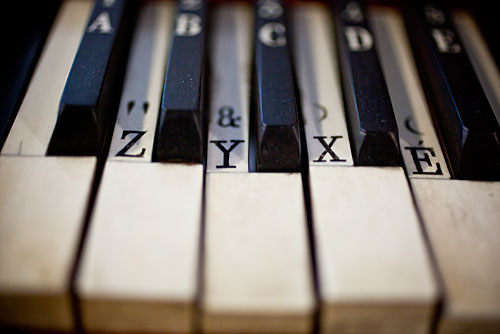
“We are teaching students and visitors about a way of engaging the world and a way of engaging history,” said Laurel Ulrich (right), Harvard’s 300th Anniversary University Professor, who helped to develop the “Tangible Things” exhibit with Ivan Gaskell, Margaret S. Winthrop Curator and senior lecturer on history. Sara Schechner (left) is the David P. Wheatland Curator of the Collection of Historical Scientific Instruments, which houses the core of the exhibition.
Photos by Justin Ide/Harvard Staff Photographer
Putting things in their place
New course, exhibition re-evaluate how items are classified
In Harvard’s Collection of Historical and Scientific Instruments, curious items are the norm, like the exploding “thunder house,” a small wooden box used to demonstrate the value of lightning rods, or the control console of the Harvard cyclotron, which was the University’s second particle accelerator.
But in the Putnam Gallery, in a display on vision and illusive nature, a giant plastic model of a human eyeball sits near the palette of the American painter John Singer Sargent, the surface of the latter covered in hardened strokes of muted color.
Hidden in several of Harvard’s collections across the University are similar treasured curiosities, part of a new class and exhibit that encourage students and visitors to question traditional categories of knowledge. “Tangible Things,” on view through May 29, is organized in collaboration with a Harvard General Education course, “Tangible Things: Harvard Collections in World History.”
“We are teaching students and visitors about a way of engaging the world and a way of engaging history,” said Laurel Ulrich, Harvard’s 300th Anniversary University Professor, who helped to develop the exhibit and course.
The core of the exhibition is in the Collection of Historical Scientific Instruments’ Special Exhibitions Gallery. There, visitors can view material categorized as art, history, archaeology and anthropology, science and medicine, books and manuscripts, and natural history, all culled from Harvard’s museums and libraries. They are also introduced to items that can’t be categorized quite so easily, including a tiger skull, a teapot, and a 100-year-old tortilla.
“Some people think these categories have outlived their usefulness. What do you think?” reads a plaque in the display.
Adding a hide-and-seek element to the show, Ulrich and co-creator Ivan Gaskell cleverly inserted a number of “guest objects” into regular displays at the Collection of Historical Scientific Instruments, Harvard Art Museums/Arthur M. Sackler Museum, Harvard Museum of Natural History, Houghton Library, the Peabody Museum of Archaeology and Ethnology, Schlesinger Library, the Radcliffe Institute for Advanced Study, and the Semitic Museum.
In the Museum of Natural History’s Glass Flowers gallery, intricate replicas of 847 species of plants handcrafted by 19th century glass artisans double as works of art. Nestled in the corner, a Louis Comfort Tiffany floriform vase, circa 1900, from Harvard Art Museums/Fogg Museum fits seamlessly into the collection.
Next door in a case in the museum’s Mineral Hall, one could easily mistake what appears to be a gray stone. But upon closer inspection, the calcified specimen, normally found in Harvard’s Countway Library of Medicine, is a bladder stone removed from a man in 1809.
Viewing an object from multiple perspectives helps students to engage, challenge their assumptions, explore history more deeply, and make connections between disciplines, said Gaskell and Ulrich. The exhibition and course are based on their work over the past several years with similar undergraduate and graduate seminars that explored how to write history from tangible things. Several items in the exhibit are objects studied by their earlier students.
“We want to encourage students to think about what purpose categorizations serve, how do they function, how do they enable us to make knowledge claims, but how do they also inhibit us,” said Gaskell, Margaret S. Winthrop Curator and senior lecturer on history.
“It’s a question of human imagination,” he added, “of not taking the line of least intellectual resistance.”

In the class, students are required to visit exhibits weekly. “Mostly we want you to look,” notes the syllabus. In addition, course participants are required to write two short papers and produce a final project based on a reinterpretation of objects in the exhibit.
The class has been a runaway hit. Last month organizers were forced to relocate its weekly lectures to a larger auditorium to accommodate the 250 students who signed up.
“I just wanted to jump into the class right away because I absolutely love the museum collections at Harvard,” said sophomore and organismic and evolutionary biology concentrator Joseph Brancale.
After reviewing a selection of personal items that Gaskell and Ulrich brought to class earlier in the semester, including a starfish, a bronzed baby boot, and a Russian icon, Brancale said he noticed “discrepancies between the [established] categories.”
“If you look at the underside of a starfish and you see the radial symmetry and all the little patterns. … You can apply that to art later on.”
At its core, the class and exhibit, said Gaskell, reflect human interaction.
“If we can help students, and anyone who is interested, to appreciate the role of things in human interactions more fully, how those relationships change over time, and how we can understand not only other people who are our contemporaries, but also those who lived before, then I think we will have done our job.”





